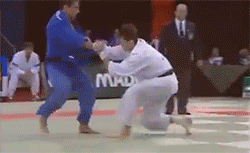
While great for controlling opponents from the back, this will not garner points in competition as to score from the back, both hooks must be placed on the inside of the opponent’s hips.Ī submission from the back where the collar is used to apply pressure to the carotid artery while the legs lock the opponent’s shoulder down, hindering their arm from fighting the choke while also making escape nearly impossible.Ī fundamental movement in jiu jitsu where the practitioner on their back will plant both heels on the mat and extend their hips into the air so that only the heels and shoulders are touching the mat.Ī fundamental movement in jiu jitsu where the practitioner performs a bridge (see bridge) and then turns to either side to end up on their knees. Usually engaged from the back (see The Back) the attacking practitioner will opt to lock their legs around their opponent’s torso with a triangle configuration (see Triangle, Sankaku). Here the attacking practitioner is positioned behind their opponent with both feet placed inside their opponent’s hips along with some form of upper body control.Īn inversion based maneuver usually initiated from the de la riva guard, where the standing opponent is swept so that their hips are on the mat where the guard player can then invert to both control and tilt their opponent and facilitate a clean path to the back. Japanese for leg entanglement (see Leg Entanglement), Ashi Garami is interchangeable with the English term single leg x (see Single Leg X), however, it is more commonly associated with situations where the hips of both practitioners are on the mat and is a big part of the leg lock game.Ī fundamental position in jiu jitsu and possibly the most dominant. While the ankle can break, common application of this submission predominantly targets the Achilles tendon.

The armbar can be applied from both the top and bottom from a variety of positions.Ī technique used both on the feet and on the mat where the attacking practitioner uses a 2-on-1 grip (see 2-on-1 Grip) to drag their opponent across their body to either hit a takedown on the feet, or take the back on the ground.Ī submission where the attacking practitioner uses their arms in a similar fashion to the triangle choke (see Triangle, Sankaku) around their opponent’s neck and arm to apply pressure to the carotid arteries.Ī submission focused on the ankle joint. The defining characteristic between the anaconda and the darce is that the attacking practitioner will go shoulder deep with their arm on the side of their opponent’s neck.Ī fundamental submission in jiu jitsu where the attacker’s whole body is focused on breaking a single arm of their opponent’s by hyperextending the elbow to a catastrophic degree. Here the attacking practitioner uses the figure 4 lock of their arms to pull the opponent’s elbow in tight to their body while gradually elevating it to break the shoulder.Ī relative of the arm triangle (See Arm Triangle) and darce (see Darce), the anaconda features a lock of the arms around the opponent’s neck, with one of their arms trapped inside. A fundamental shoulder lock where the opponent’s arm is bent to a ~90° at the elbow with their fist pointing towards their head, as if they were flexing their biceps.


 0 kommentar(er)
0 kommentar(er)
